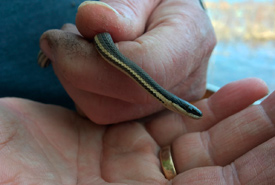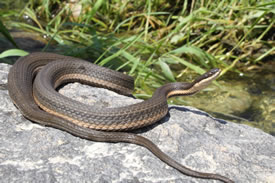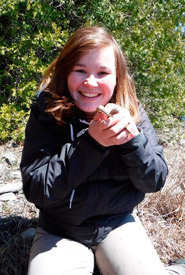Treasure hunting: The quest for queen snakes

Queen snake found on the Saugeen Bruce Peninsula in 2017. When these snakes are observed, not only do we look for signs of snake fungal disease, we also examine them for signs of injury and measure them so we can better understand the number of young versus adults in the population. (Photo by NCC)
Paddling across the lake, fellow staff from the Nature Conservancy of Canada (NCC) and I couldn’t contain our excitement. It was the first day of our annual queen snake surveys, and we were all curious about what we might find.
I often think of being a conservation biologist as like being a treasure hunter. You never know what you might find when you carefully look under a rock or a log, or what plants you may find or birds you’ll hear when you walk in a forest, or what herptiles (reptiles and amphibians) you might stumble across. This summer, NCC staff completed several surveys for herptile species at risk on the Saugeen Bruce Peninsula, in Ontario, including queen snake and massasauga rattlesnake. In Ontario there are 55 herptiles, including 18 snake species.

Queen snake found during 2013 survey, ON (Photo by Joe Crowley)
For the past few years, NCC staff have been completing surveys for the endangered queen snake on the Saugeen Bruce Peninsula, in partnership with other organizations, such as the Huron Stewardship Council. These cryptic snakes are not easy to find. There’s only one known population of queen snake on the Peninsula, and unlike other populations in Ontario found commonly along rivers, these are found in lakes.
Queen snakes are dark brown with a distinctive yellow belly and four dark stripes running along the sides of their bodies. They can grow up to a metre in length. These snakes are very aquatic, swimming and basking in open water and in shrubs along the edge of the water. However, they’re most often found under rocks. Interestingly, their diet consists almost exclusively of freshly molted crayfish.
NCC and others organizations across Ontario have been trying to find out more about these snakes, as much remains unknown. This year, NCC staff and volunteers were lucky enough to spot 17 queen snakes throughout the surveys. This was more than had ever been recorded in the area. During the surveys, more than 250 snakes from eight different species were identified, as well as a new observation of a four-toed salamander in the survey area.

Esme Batten, NCC’s coordinator, conservation biology for the Saugeen Bruce Peninsula, holds a young queen snake. NCC’s queen snake project has multiple permits to complete these project, such as Animal Care Permits and Wildlife Science Collectors Authorization, among others. These permits allow us to carefully handle species in order to collect important data about health, diet and population dynamics. We employ rigorous sterile techniques, and only handle animals when absolutely necessary. (Photo by NCC)
Gathering more information about these populations and their distributions can help conservation organizations such as NCC work to protect species. Whether it be through directly protecting land where these species are found, completing restoration work in suitable habitat (such as invasive species management or habitat creation) or gathering information about habitats that these snakes use, to help identify new populations, all of the information collected is valuable to their protection.
Unfortunately, there are many threats to Ontario’s herptiles. Wetland drainage, forest clearing and an ever-increasing human footprint threaten many snakes across the province, especially queen snake. They are very sensitive to environmental contamination, as are populations of crayfish, which the queen snake relies on. As these snakes are often found along river and lake edges under rocks, snakes may be crushed by vehicles or pedestrians.
In addition to the above threats, snake fungal disease (SFD) is an emerging threat to snake species across Canada. Little is known about the disease, or its potential impact on snake populations, its distribution and even its origin. SFD is a debilitating skin disease syndrome that affects several snake species across eastern North America.
SFD was first reported in New Hampshire, and is most prevalent in the eastern United States. However, there are now confirmed cases of the disease in Ontario, including a queen snake on the Saugeen Bruce Peninsula that tested positive for the presence of the disease. More research is needed to learn more about SFD in Ontario, and projects such as NCC’s queen snake surveys will provide more information about the disease’s distribution and its impact on individuals and larger populations.
In order to prevent this disease and others from spreading, people should not handle herptiles. Researchers collecting data from animals employ rigorous cleaning techniques and only handle animals when absolutely necessary, with appropriate permits in place from government organizations, such as the Ministry of Natural Resources and Forestry.
So, the next time you are out in nature picture yourself like a treasure hunter uncertain of what you might find. You never know what you might come across!


